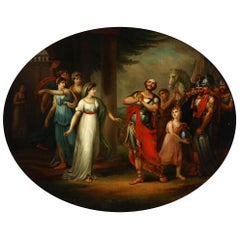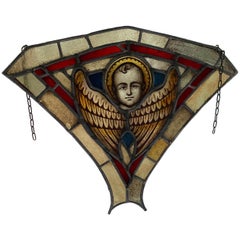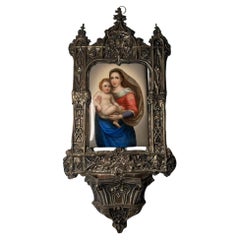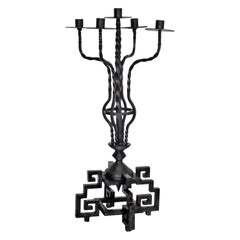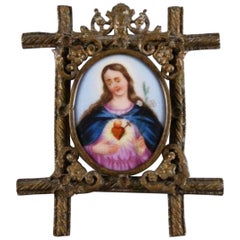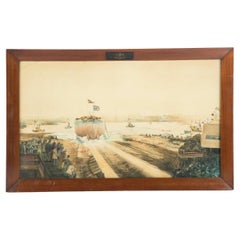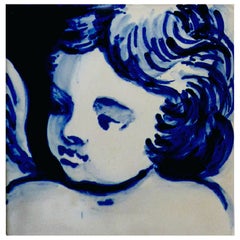Hand-Painted Religious Items
Color: Black
Technique: Hand-Painted
Jephthah the Gileadite Returning Home, circa 1800
Located in Virum, DK
Jephthah the Gileadite returning home after destroying the Ammonite towns. Unsigned. Oil on metal. Scene from The Book of Judges chapter 11, 30–40.
Category
Early 1800s Antique Hand-Painted Religious Items
Materials
Metal
Antique Gothic Revival Stained and Glass Window Hanger Panel with Young Christ
Located in Lisse, NL
One of a kind, 19th century leaded and stained glass panel.
This incredibly well made glass window frame depicting a beautifully hand painted angel is another one of our recent great finds. The serenity and innocence that this child Jesus radiates reveils the quality of the workmanship of the artisan who created this work of religious art. This unique and highly decorative antique fragment...
Category
Late 19th Century European Gothic Revival Antique Hand-Painted Religious Items
Materials
Lead
Wall Brass Holy Water Font Hand Painted Porcelain of the Sistine Madonna
Located in Guaynabo, PR
This is a hand painted KPM style rectangular plaque of the Sistine Madonna framed in a wall brass holy water font. The brass frame depicts three arcs, two small semicircular in the s...
Category
Early 20th Century Unknown Renaissance Hand-Painted Religious Items
Materials
Brass
Wrought Iron Church Torchère with Five Candleholders, Italy, Early 19th Century
Located in Frankfurt am Main, DE
A rare Italian heavy wrought iron church five-light torchère, black painted raised on a large square geometric base, Italy, early 19th-century. This torchére is in good condition, wi...
Category
Early 19th Century Italian Renaissance Revival Antique Hand-Painted Religious Items
Materials
Wrought Iron
Spanish Virgin Mary Painting on Porcelain Framed in Gold Gilded Bronze Pendant
Located in Frankfurt am Main, DE
A beautiful Gothic Revival painting on porcelain plaque of an oval bust portrait of Virgin Mary pendant mounted in a gold gilded bronze frame, Spain...
Category
Late 18th Century Spanish Gothic Revival Antique Hand-Painted Religious Items
Materials
Bronze
Early 19th Century Pair of Italian Wrought Iron Church Torchères, Candleholders
Located in Frankfurt am Main, DE
Great pair of Italian Renaissance Revival wrought iron church torchères raised on a large tripod base, early 19th-century. The candleholders are finely handcrafted with elegant detailing and are black painted. Both pieces are in good condition, with original black paint, remained melted wax...
Category
Early 19th Century Italian Renaissance Revival Antique Hand-Painted Religious Items
Materials
Wrought Iron
17th-18th Century the Holy Virgin Mary's Soul Being Pierced by a Sword
Located in Virum, DK
17th-18th century: The holy Virgin Mary's soul being pierced by a sword. Unsigned. Oil on canvas. 91.5 × 67 cm. Unframed.
Category
Mid-18th Century Italian Antique Hand-Painted Religious Items
Materials
Canvas
18th Century the Immaculate Conception, Unsigned
Located in Virum, DK
Painter unknown, 18th century: The immaculate conception. Unsigned. Oil on canvas laid on canvas. Ca. 67 × 52 cm. Unframed.
Category
Mid-18th Century Italian Antique Hand-Painted Religious Items
Materials
Canvas
17th-18th Century Jesus with the Cross, Unsigned, Oil on Canvas Laid on Wood
Located in Virum, DK
Jesus with the cross wearing the crown of thorns, verso portait of Jesus wearing the crown of thorns. Unsigned. Oil on canvas laid on wood. 134 × 76 cm. Unframed.
Category
Mid-18th Century Italian Antique Hand-Painted Religious Items
Materials
Canvas
Italian School, 18th Century The Good Samaritan, Unsigned
Located in Virum, DK
The good Samaritan. Unsigned. Oil on canvas. Measures: 80 x 100 cm.
Provenance: Former chief curator at The Royal Collection of Prints and Drawings a...
Category
Mid-18th Century Italian Antique Hand-Painted Religious Items
Materials
Canvas
Devotional Statues / Religious Sculptures of St. Francisco de Jesus Marto & More
Located in Lisse, NL
Antique and extremely rare Christian sculptures with maker's marks.
These highly collectible devotional sculptures date from the early 1900s and they are both marked on the back. Be...
Category
Early 20th Century European Hand-Painted Religious Items
Materials
Cement
17th Century Old Master Oil Painting Saint Bernard of Clairvaux, Spanish School
Located in Vero Beach, FL
17th century old master oil painting of Saint Bernard of Clairvaux. Spanish school.
Dramatic expression and perfect use of chiaroscuro, the art of light and shadow effects, makes th...
Category
17th Century Spanish Baroque Antique Hand-Painted Religious Items
Materials
Canvas
Related Items
Late 19th century Pair of Cast Iron Andirons
Located in Lymington, Hampshire
A pair of large cast iron andirons in the form of Tweedleddee and Tweedledum, late 19th century.
Category
1870s English Antique Hand-Painted Religious Items
Materials
Iron
George Edward Horton: the Launch of H.M.S. ‘Victoria’ from the Elswick Shipyard
Located in Lymington, Hampshire
George Edward Horton: The Launch of H.M.S. ‘Victoria’ from the Elswick shipyard of Sir W. G. Armstrong Whitworth and Co. Ltd, Newcastle-upon-Tyne in 1887, watercolour and pencil heig...
Category
1880s European Antique Hand-Painted Religious Items
Materials
Paint
H 15 in W 25 in D 1 in
Antique French Oak Gothic Revival Panel
Located in Denton, TX
French oak hand carved Gothic revival panel. There are three available. Each panel is 1" deep by 8.5" wide by 13" high.
Category
19th Century French Gothic Revival Antique Hand-Painted Religious Items
Materials
Oak
Late 19th Century Iraqi Silver Hanukkah Lamp
Located in New York, NY
Unique silver Hanukkah lamp, Iraq, circa 1880.
On four feet, a handmade silver tray with nine candle holders for eight days of Hanukkah, and one for t...
Category
Late 19th Century Iraqi Antique Hand-Painted Religious Items
Materials
Silver
Mark Rothko: The Works on Canvas (Book)
Located in North Yorkshire, GB
This book is the first volume of the definitive catalogue raisonne of the work of Mark Rothko, one of the greatest abstract artists of the 20th century. It documents his entire outpu...
Category
20th Century Hand-Painted Religious Items
Materials
Paper
Mid-20th Century Israeli Iron Shabbat Candle Holder by David Palombo
Located in New York, NY
Iron Shabbat candle holder crafted in brutalist style by David Palombo. Made for two candles, each of the holders is decorated with petals-like s...
Category
Mid-20th Century Israeli Brutalist Hand-Painted Religious Items
Materials
Iron
Jugendstil WMF Marked and Silvered Holy Water Font Depicting Mary & Child Jesus
Located in Lisse, NL
Antique silvered wall font with original and excellent condition glass vessel.
This rare Jugendstil wall font by German makers WMF is in excellent condition and it even comes with t...
Category
Early 20th Century German Jugendstil Hand-Painted Religious Items
Materials
Metal
Free Shipping
H 10.4 in W 5.9 in D 1.9 in
Fine 19th Century French Neo-Gothic Gilt Metal Cathedral Church Reliquary Pair
Located in Forney, TX
A stunning pair of very fine quality French Neo-Gothic gilt metal church reliquaries. circa 1860s
Most impressive objets d’art, born in France in the second half of the 19th century, most likely Parisian gilded bronze and brass ormolu work, exceptionally executed sculptural form, the exquisitely detailed architectural cathedral shaped case having a removable pointed steeple roof with cross finial, opening to relic display case surrounded on all sides by original glazed glass panes, stepped base, rising on disc feet. Signed, stamped by maker / bronzier "BC" (unknown) model "5096" and other faint marks to lid interiors.
Additional photos available upon request
Dimensions: (approx)
14.75" High, 6.75" Wide, 6.75" Deep; 13.25 lbs total
History:
A reliquary (also referred to as a shrine, by the French term châsse or monstrance) is a container for important religious relics.
The earliest reliquaries were essentially boxes, either simply box-shaped or based on an architectural design, taking the form of a model of a church with a pitched roof. These latter are known by the French term chasse, and typical examples from the 12th to 14th century have wooden frameworks with gilt-copper plaques nailed on, decorated in champlevé enamel. Limoges was the largest production centre; NB the English usage differs from that of the French châsse, which denotes large size rather than shape.
Relics of the True Cross became very popular from the 9th century onward and were housed in magnificent gold and silver cross-shaped reliquaries decorated with enamels and precious stones. From about the end of the 10th century, reliquaries in the shape of the relics they housed also became popular; hence, for instance, the skull of Pope Alexander I was housed in a head-shaped reliquary. Similarly, the bones of saints were often housed in reliquaries that recalled the shape of the original body part, such as an arm or a foot.
A philatory is a transparent reliquary designed to contain and exhibit the bones and relics of saints. This style of reliquary has a viewing portal to view the relic inside. The feretrum was a medieval form of reliquary or shrine containing the sacred effigies and relics of a saint.
During the later Middle Ages, the monstrance form, primarily used for consecrated hosts, was sometimes used for reliquaries. These housed the relic in a rock crystal, or glass capsule mounted on a column above a base, enabling the relic to be displayed to the faithful. Reliquaries in the form of large pieces of metalwork jewellery also appeared around this time, housing tiny relics such as pieces of the Holy Thorn, notably the Holy Thorn Reliquary now in the British Museum.
Condition:
Superb museum quality examples, in excellent original unrestored antique condition with beautifully aged patina. Wear consistent with age and use. Heavily patinated - scattered oxidation. Overall wonderful examples.
Typically reliquaries were not sold in pairs, so to find a matching pair such as this is exceptionally rare.
Worldwide shipping available
Local pickup available near Dallas, Texas
Additional:
We here at Lynx Hollow Antiques love religious antiques, from Christian tabernacles, Catholic altarpiece, life-size Buddhist temple sculptures, Hindu votive offerings, 16th century Islamic mosque architectural salvaged windows...
Category
Mid-19th Century French Gothic Revival Antique Hand-Painted Religious Items
Materials
Brass, Bronze
H 14.75 in W 6.75 in D 6.75 in
Italian Antique Wooden Angel
Located in Alessandria, Piemonte
Antique wooden angel from the mid 1800's, with traces of lacquer but no trace of gilding: I could gild it, but I prefer it as it is.
To hang anywhere You ...
Category
Mid-19th Century Italian Neoclassical Antique Hand-Painted Religious Items
Materials
Wood
Mid19th Century Spanish Virgin Mary of the Sacred Heart Painted Wooden Sculpture
Located in Marbella, ES
Antique mid-19th century Spanish hand carved painted wooden sculpture of Virgin Mary of the Sacred Heart with glass eyes.
Category
19th Century Spanish Antique Hand-Painted Religious Items
Materials
Wood
H 23.63 in W 7.88 in D 6.3 in
Selection of eight restored 19th C Neo-Gothic Stained-Glass Windows
Located in Leuven , BE
The Color Experience: Stained-glass windows
“Color is a power which directly influences the soul” (Wassili Kandinsky, Moskou 1866 – Neuilly-sur-Seine, 1944)
“Color! What a deep and mysterious language, the language of dreams!” (« La couleur ! Quelle langue profonde et mystérieuse, le langage des rêves », Paul Gauguin, Paris, 1848-Fatu-Hiva, 1903)
‘Color and feeling’, ‘color and meaning’, these are concepts that have gone together since time immemorial. Artists and craftsmen have a special bond with color. After all, it is a means of expression that can have a real reinforcing effect. Especially linking color with light offers unlimited possibilities. Glaziers and glass painters have tried to master both these ‘instruments’ for centuries.
The set of beautifully restored neo-Gothic windows in our collection are enough reason for us to let these works of art figure in a broader story. As a bonus, we would like to introduce you to the contemporary stained-glass artist and stained-glass restorer, Daniël Theys. whose workshop is in Sint-Pieters-Rode (Belgium). He talked to us about the materials and techniques he used for the restoration of our set of neo-Gothic stained-glass windows. A fascinating look at the tricks of the trade from a specialist!
A bird’s eye view of the history of the European stained-glass window.
Although the Romans already used translucent glass plates to cover wall openings, the stained-glass window reached its peak in Europe between 1150 and 1500. A period also known as the era of the cathedrals. At that time, stained-glass windows became more than just a way to let in the light, and to keep the space closed off. From now on, their functionality was also found in their didactic value. The biblical and saints’ stories that adorned the stained-glass windows became a kind of poor man’s bible. They brought, as it were, the knowledge of the holy scriptures in an understandable, pictorial way. At the same time, the colored light provided additional symbolism. The invading light was interpreted as a manifestation of God. It is also no coincidence that the main altar was bathed in light. It was the place where the most important sacrament was celebrated, that of the Eucharist. How were these magical colors obtained? Well, during the 12th and 13th centuries, metal oxides gave color to the glass. Copper, for example, produced different colors in the various stages of oxidation. The metal could color the glass light blue, green and even red. It should be noted that from the 13th century onwards, clear glass, which was cheaper and at the same time allowed more light into the buildings, was used more often. A century later, in the years 1400 to 1500, glass painters frequently painted onto the glass with a ‘stain’ of silver chloride or sulfide. The painted piece of glass was heat-treated in a furnace. The heating process ensured that the silver ions migrated into the glass and became suspended within the glass network. The stain gave colors ranging from a pale yellow to a rather deep red. This new technique allowed glaziers to get more than one color on a single glass fragment. The shades produced by painting in silver chloride were well suited for depicting golden crowns, scepters and other gilded objects and ornaments. But the most important advantage of the technique was the fact that the glass painter could now make transitions from yellow tones to white without having to apply separations with lead strips! This also improved the legibility of the pictured scene.
You can imagine that the labor-intensive process of the production of stained-glass windows was a very costly affair and therefore it was often patrons who donated them to a church or a chapel. The benefactors were usually eager to propagate their social status and were moved by concern for their salvation.
In the 16th century, stained-glass windows also began to appear in secular buildings such as town halls, the homes of the wealthy and commercial premises such as inns. It is striking that during this period the use of lead strips that border many parts of the image was further reduced in favor of real painting on stained glass. This was due to an increasing love of detail. For example, one wanted realistically painted portrait heads. Working with enamel paints was cumbersome. Each newly applied color had to be burned into the glass before another color or overpainting could be applied. It was not only the coloring of the glass that was complicated, the process of obtaining flat glass plates required many steps as well. The glazier blew a glass bulb with a blowpipe and then cut it open. Finally, each half of the sphere was turned around so fast that it became a disc. In later periods, the glazier blew out his glass bulb into a cylinder. Once the cylinder had cooled, its closed ends were removed, and the long sides were cut open. The pieces of glass obtained were then heated and flattened. During the 16th century, there was a division of labor between the stained-glass designer, the glazier, and the glass painter. It happened as well that the stained-glass artist used prints as models for his stained-glass windows. Whoever drew the design, the glazier always needed a model on the right scale, the so-called cartoon. On the cartoon, the lead strips were clearly marked, and the use of colors was indicated. Contracts at the time show that the price of stained-glass windows was calculated per square foot. The price per square foot included the labor and material costs. The price of the cartoon was not included.
In the 17th century, the work of glass painters remained important. At the same time, there was a growing popularity of stained-glass windows with heraldic themes. In the Low Countries there were several high-quality glass painters active.
During the 18th century, glass painting went downhill in our regions. The French occupation of the Southern Netherlands resulted in the destruction and sale of religious stained-glass windows.
It was only around the middle of the 19th century that the young Belgian state experienced a revival of stained glass. The renewed interest in the Middle Ages, the so-called ‘gothic revival’, caused a wave of restoration of old stained-glass windows of churches and orders for neo-gothic stained-glass windows. The Sint-Lucas art schools in Belgium played an important role in this. Industrial developments in the glass and steel industries naturally had an important hand in the popularity of stained-glass windows. Stained-glass had a wide range of uses; think of stained glasses in winter gardens, domes, windows, and doors of large mansions. Significant glazier’ studios arose in several larger Belgian cities. In Brussels, for example, you had the workshops of Capronnier and Colpaert, in Bruges the studios of Coucke and Dobbelaere, in Ghent the companies of Ganton-Defoin or Ladon. During the 19th century, glaziers followed the style developments in the visual arts. For example, the number of windows in Art Nouveau and Art Deco style is large. The restored stained-glass windows with male and female saints that we offer for sale, come from a building in Laeken, near Brussels. They probably decorated the space of a church, chapel, convent, or Catholic school. In the results of the interview with glass restorer Daniël Theys, you will learn more about the particularities of these splendid windows.
Chatting and browsing in the workshop of Daniël Theys
The Belgian Glass restorer and glass blower, Daniël Theys (), made a career switch at a later age and has been active in the profession since 1987. He is an important player in the field of stained-glass window art in Belgium. Moreover, he is the only one in the country who still masters the technique of glass etching. Daniël Theys receives many commissions from small parish churches to restore old stained-glass windows to their former glory. He made a name for himself in that niche and that is how Spectandum brought the set of 19th century stained glass windows to his workshop for reconstruction. They were delivered in old numbered wooden crates and Daniel had to start puzzling.
Numbered wooden crates with sections of the stained-glass windows
Normally a glazier starts working from a drawing with a scale of 1:1 (full size drawing), but in this case each piece had to be cataloged and photographed. The smaller pieces were grouped on the light box and photographed in their entirety. Then Daniël made a drawing of the remaining pieces that he had puzzled together with great care.
Smaller pieces identified and grouped on the light box
The restauration guidelines of the Agency for Monuments and Landscapes are not always the same as those of a restorer. For this reconstruction, Daniël primarily considered the purpose of the stained-glass windows. It had to be an aesthetic and salable set of stained-glass windows, so the choice of filling the gaps with neutral glass or epoxy was not really an option. Theys left well-executed previous restorations untouched. The windows may have been repaired three or four times in the past.
Piece of a cloak with glass shards from different periods (restorations)
Another problem Daniel faced during the restoration was the fact that some small parts of the old grisaille had been eaten away by microorganisms. The defect – caused by moisture – can be seen from the discoloration of the grisaille. The black-brown color is turned red.
This fragment shows well how the brown grisaille has turned red due to the attack of micro-organisms
The stained-glass windows of the 19th century are made of ‘in the mass-colored’ glass. This means that the colors were added to the liquid glass during its production process. This type of glass differs from glass colored with enamel paint, which became popular from the interwar period. The latter process involves applying enamel paint (this is a glass powder with a metal oxide to which a medium has been added) to the colorless glass. When firing the glass with the enamel paint, the powder fuses with the glass. The colors of email painted glass are less intense and less brilliant than those of ‘in the mass-colored glass’.
Jars with colored powder for the enamel paints
For the restoration Daniël only worked with mouth-blown glass, both with ‘in the mass-colored glass’ and with ‘verre plaqué’. This is blown glass composed of several layers of different shades. Over the years, Theys built up a large stock of old blown glass. Colored blown glass always has sliding shades. For example, a red piece of glass can have a color transition from bright red to light orange. These differences in shades are the result of the different thicknesses of the piece of glass. It allows the glazier to use a wide variety of shades.
The purple-red foliage with light blue accents was obtained by etching away parts of a piece ‘verre plaqué’. A small part of the lower glass layer is exposed.
The windows were completely re-leaded by the restorer because there was virtually no ‘lead net’ preserved. In general, lead strips only have a limited lifespan because of oxidation processes. Daniël removed the old lead remnants and placed new lead profiles. Then he applied putty between the glass fragments and the lead strips to seal the lead. A window must be made watertight. The current condition of the windows is excellent.
Decorative glass part with original lead remnants
New lead strip
The set of stained-glass windows we present today, originally consisted of windows of 5 to 6 m high. After all, they originally adorned a neo-gothic church. Since the original dimensions are not suitable for private buildings, it was decided to only restore the figurative representation.
The original spire of one of the windows
Thanks to a suspension eye, the window can be hung. There is also the possibility to place the window in an upright position.
Thanks to the craftsmanship of the Theys-Studio, we can once again enjoy the brilliance of color!
Looking for the missing link
The set of 19th-century stained-glass windows came into the possession of Spectandum without a clear provenance. The renowned Leuven antiques dealer, Cornelius Engelen, recalls that the windows came from a church in Laeken. There is no solid starting point for a search for the provenance. Based on the style of the stained-glass windows – most probably the late 19th century -, their religious iconography, and their original shape (pointed arch windows) and dimensions (5 to 6 cm high), we can assume that they were once displayed in a (neo-)gothic cult building. On the one hand, the stained-glass windows may have been removed after storm damage or other calamities, on the other they may have been taken away during a renovation or a demolition of a church. The Church of Our Lady in Laeken is the most famous church building in that municipality that could qualify. In the early 1920s, the central windows of the transept were badly damaged by a hurricane. Today, glass fragments of these windows (dating from 1893-1894) with the names of the sixteen missing saints and an arch infill of the western window are officially known. It would be interesting to find out if our set of eight saints once were part of the transept of Our Lady in Laeken. Research in the records of the church administrators could provide clarification. Knowing that most neo-gothic stained-glass windows from the Church of Our Lady come from the Jules Dobbelaere’s glass studio in Bruges, it is useful to consult that company’s archive as well. It is kept in the KADOC (Documentation and research center for religion, culture and; in Leuven. Of course, the sizes and shape of the stone window openings of the transept can also provide an indication. If we stylistically compare the grisailles of the set of stained-glass windows with the work of Jules Dobbelaere, we do see some relationship. Especially with a stained-glass window in the chapel of Our Lady of the Saint Anthony Church in Aalst.
Another line of research that we could follow, is that of the iconography of the series. One of the saints depicted is Saint Roch. There once was a Saint-Roch church in Laeken with 19th-century stained-glass windows from the Brussels studio of Jean-Baptiste Capronnier. The company archive of the glaziers François and Jean-Baptiste Capronnier is owned by the Flemish government and can be consulted in the above-mentioned KADOC. We already searched the sales catalog of 1892, in which Capronnier’s drawings and cartoons are described one by one. The saints that are represented in our set of windows, does not correspond with the names of the saints mentioned for the church of St. Roch in Laeken. Building on this argument, it can be concluded that the eight saints were not destined for this house of worship.
In the absence of lavishly illustrated monographs on the various glazier-companies in Belgium, the execution of a comparative study of the stained-glass windows is time-consuming and complex. Although a limited number of old photos of stained-glass windows can still be found in the database ‘Balat’ of the KIK-IRPA (), this remains far too limited to get a good picture of the output of the various companies.
19th C, Saint, Neo-Gothic Stained-Glass Window with Saint Martin, Belgium, 163 x 73 cm
Most people know Saint Martin (Szombathely, ca. 316 – Candes, 397) as the Roman Tribune who cut his cloak in two with his sword and gave one half to a beggar. The artist of the stained-glass window has opted for a different, less common iconographic representation here. Saint Martin is presented as a bishop with a miter and staff. According to a legend, Martin was lured to the city of Tours with a trick to consecrate him as a bishop. He refused the ecclesiastical office and hid in a barn with some geese. The birds betrayed him with their twittering. In the end Martin received his episcopal consecration. The goose at the feet of the saint clearly refers to this event.
19th C, Saint, Neo-Gothic Stained-Glass Window with St. Angela, Belgium, 163 x 73 cm
Angela de Merici was an Italian woman who taught young women religion, health care, and household skills. She founded the monastic community of the Ursulines. They played an important social role as founders of schools and orphanages. Saint Angela died in Brescia in 1540. It should therefore come as no surprise that the saint on the stained-glass-window is depicted with
a girl by her side.
19th C, Saint, Neo-Gothic Stained-Glass Window with Charles Borromeo, Belgium, 163 x 73 cm
Charles Borromeo (Milan, 1538-1584) grew up in a noble family. He was already made Cardinal and Archbishop of Milan at the age of 24. With his writings he contributed to the implementation of the Church reforms determined at the Council of Trent. Among other things, he released a new catechism. With his book on the design of church buildings, “Instructiones Fabriacae et Supellectilis Ecclesiasticae”, he left a mark on Baroque church construction. At the outbreak of the plague in his diocese in 1576, he devoted himself to the care of those affected. Hence, people sometimes pray to him when they have been hit by a serious illness.
19th C, Saint, Neo-Gothic Stained-Glass Window with St. Roch, Belgium, 163 x 73 cm
Saint Roch (Montpellier, 1295? /1350? -1327? /1380?) was born with a port-wine stain in the shape of a cross on his left hip. It was interpreted as a sign from God. After the dead of his parents, he gave his money to the poor and went on to live the life of pilgrim. He cared for plague sufferers and healed some of them by making a sign of the cross. He is especially invoked as protector against the plague.
19th C, Neo-Gothic Stained-Glass Window with St. Bernard of Clairvaux, Belgium, 163 x 73 cm
Bernard of Clairvaux (Fontaines, 1090-Clairvaux, 1153) decided to become a monk at the age of 21. In 1112 he entered in the monastery of Cîtaux. He was soon commissioned by the abbot to find a new monastery in Clairvaux. Because of his intellectual capacities and eloquence, he was consulted by various ecclesiastical and secular leaders. He ensured the expansion of the Cistercian order throughout Europe. As a Doctor of the Church, he wrote many tracts and sermons and established a new rule for the Templars. Above all, he was concerned with the discipline of the clergy. Therefore, he wrote a spiritual manual for the priests and bishops. Saint Bernard can be seen as a true mystic. He envisioned the union of the human soul with God as the most important goal in life. According to a legend, Bernard once had a vision in which the Blessed Virgin appeared to him and strengthened him with her mother’s milk. In the arts, the saint is mainly depicted with an abbot’s staff and a book with the Cistercian rule. His vision was also often portrayed.
19th C, Neo-Gothic Stained-Glass Window with St. John Berchmans, Belgium, 163 x 73 cm
The Belgian Jan Berchmans (Diest, 1599-Rome, 1621) was the eldest of five children. When his mother became seriously ill, he initially took care of her, but at the age of nine he was housed with the town’s priest. After a few years he moved to Mechelen to become the servant of a canon. It also gave him the opportunity to begin his studies in the seminary for priests. He eventually joined the Jesuits of Mechelen. He got their permission to study philosophy in Rome. In the Eternal City, he visited working-class neighbourhoods to teach the children about God. He died of an illness at the age of 22. Saint Jan Berchmans is the patron saint of school children and students.
19th C, Neo-Gothic Stained-Glass Window with Saint Clare...
Category
19th Century Belgian Gothic Revival Antique Hand-Painted Religious Items
Materials
Art Glass, Stained Glass
Christianity Monastery Work Virgin Mary in Glass Display Case Antique German
Located in Nuernberg, DE
Here I have to offer a fine antique classic early 20th century Glass Display Case with a beautiful Monastery Work inside. A wonderful decorative item, in very nice as is condition.
T...
Category
Late 19th Century German Folk Art Antique Hand-Painted Religious Items
Materials
Glass, Wood, Paper
Previously Available Items
19th Century English Leather Bound and Brass Locks Holy Bible Illustrated
Located in Dallas, TX
This beautiful antique family Bible was printed in England circa 1870. Titled Brown's Self-Interpreting Family Bible containing the Old and New Testament; to which are annexed an extensive introduction; marginal references and illustrations; an exact summary of the exact books; a paraphrase of the most obscure or important parts, explanatory notes, evangelical reflections, etc... Many additional references and a life of the author, with numerous colored illustrations in oil and on steel. The bible is in very good condition commensurate with age and use, and adorns a rich patinated black leather with gilt accents, and antiqued brass locks...
Category
Late 19th Century English Antique Hand-Painted Religious Items
Materials
Leather, Paper
Blue Hand Painted Baroque Cherub or Angel Portuguese Ceramic Tile Azulejo
Located in Coimbra, PT
Gorgeous blue hand painted Baroque cherub or angel 18th century style Portuguese ceramic tile/azulejo
The tile painted in cobalt blue over white in typ...
Category
Late 20th Century Portuguese Baroque Hand-Painted Religious Items
Materials
Delft, Faience, Terracotta
H 0.4 in W 5.91 in D 5.91 in
17th Century Italian Black Cross with Black Crystal Quartz on a Crystal Cluster
By Interi
Located in Dublin, Dalkey
17th century Italian cross adorned with black crystal quartz points and mounted on a black crystal quartz cluster.
The black crystals have been applied onto the cross to look as though naturally grew on the piece. The cross as a result looks "crystalized" as the minerals match the original paint of the 17th century cross...
Category
17th Century Italian Baroque Antique Hand-Painted Religious Items
Materials
Quartz, Rock Crystal
H 13.5 in W 27.5 in D 7 in
Blue Hand Painted Baroque Cherub or Angel Portuguese Ceramic Tile or Azulejo
Located in Coimbra, PT
Gorgeous blue hand painted Baroque cherub or angel 18th century style Portuguese ceramic tile/azulejo
The tile painted in cobalt blue over white in typical 18th century Portugal set...
Category
Late 20th Century Portuguese Baroque Hand-Painted Religious Items
Materials
Delft, Faience, Terracotta
H 0.4 in W 5.91 in D 5.91 in
17th Century St. Francis in Prayer Emilian School Painting Oil on Canvas
Located in Milan, IT
17th century, Emilian school
St. Francis in prayer
Measures: Oil on canvas, 92 x 96.5 cm
Frame 99 x 104 cm
The work in question depicts St. Francis of Assisi with his ha...
Category
17th Century Italian Antique Hand-Painted Religious Items
Materials
Canvas
H 38.98 in W 40.95 in D 1.58 in
Antique Religious Hand Painted Icon on Board with Silver Embellishments 19th C
Located in Big Flats, NY
An antique icon offers hand painted figure on wood board with silver embellishments including crown, hand with crucifix and mask, 19th century
Measures...
Category
19th Century European Antique Hand-Painted Religious Items
Materials
Silver
H 9.5 in W 7.5 in D 1 in
17th Century Spanish Old Master Painting, The Birth of the Virgin
Located in Vero Beach, FL
17th century Spanish Old Master painting. The Birth of the Virgin.
Important Old Master painting, oil on canvas, presents the scene of ...
Category
17th Century Spanish Baroque Antique Hand-Painted Religious Items
Materials
Canvas
Antique Leaded and Hand Decorated Stained Glass Window, St Cecilia & Piano
Located in Big Flats, NY
An antique leaded and hand painted stained glass window depicts Saint Cecilia seated at her piano, title panel and foliate decorated frame as photographed, architectural element, 19th century
Measures: 39" H x 26" W x .25" D
Additional information:
Saint Cecilia (Latin: Sancta Caecilia), is a Roman martyr venerated in Catholic, Orthodox and Anglican churches. She became the patron of music and musicians, it being written that, as the musicians played at her wedding, Cecilia "sang in her heart to the Lord".[2][3] Musical compositions are dedicated to her, and her feast, on 22 November,[4] is the occasion of concerts and musical festivals.
St Cecilia...
Category
19th Century American Antique Hand-Painted Religious Items
Materials
Lead
Blue Hand Painted Baroque Cherub or Angel Portuguese Ceramic Tile or Azulejo
Located in Coimbra, PT
Gorgeous blue hand painted Baroque cherub or angel 18th century style Portuguese ceramic tile/azulejo
The tile painted in cobalt blue over white in typical 18th century Portugal set...
Category
Late 20th Century Portuguese Baroque Hand-Painted Religious Items
Materials
Delft, Faience, Terracotta
H 0.4 in W 5.91 in D 5.91 in
Blue Hand Painted Baroque Cherub or Angel Portuguese Ceramic Tile or Azulejo
Located in Coimbra, PT
Gorgeous blue hand painted Baroque cherub or angel 18th century style Portuguese ceramic tile/azulejo
The tile painted in cobalt blue over white in typical 18th century Portugal set...
Category
Late 20th Century Portuguese Baroque Hand-Painted Religious Items
Materials
Delft, Faience, Terracotta
H 0.4 in W 5.91 in D 5.91 in
Blue Hand Painted Baroque Cherub or Angel Portuguese Ceramic Tile or Azulejo
Located in Coimbra, PT
Gorgeous blue hand painted Baroque cherub or angel 18th century style Portuguese ceramic tile/azulejo
the tile painted in cobalt blue over white in typical 18th century Portugal set...
Category
Late 20th Century Portuguese Baroque Hand-Painted Religious Items
Materials
Delft, Faience, Terracotta
H 0.4 in W 5.91 in D 5.91 in
19th Century English Leather Bound and Brass Locks Family Holy Bible
Located in Dallas, TX
This beautiful antique family bible was printed in England circa 1870, with an abridgement of the commentaries of Scott and Henry, and containing also many thousand critical and explanatory notes selected from the Standard Authors of Europe and America. The commentaries condensed and the whole edited by the late Reverend John Eadie, professor of biblical literature to the United Presbyterian Church. The book flaunts an engraved brown leather and gilt covering, and is embellished with two brass locks and embossed brass edges. The bible features the old and new testament, and is fully illustrated with plates from original paintings by eminent artists; it also has colored maps, family register, roll of honor and the Lords Prayer...
Category
Late 19th Century English Antique Hand-Painted Religious Items
Materials
Leather, Paper
Recently Viewed
View AllMore Ways To Browse
Jesus Crucifix
Rare And Antique Bibles
Church Prayer
Metal Crucifix
Wood Carved Crucifix
Jewish Religious Items
Prayer Stand
Menorah Lamp
4 Amazing Gothic
Corpus Of Christ
Mid Century Modern Crucifix
Monastery Doors
Silver Crucifix
Antique Carved Wood Saint
Antique Altar Religious
Biblical Items
Holy Jesus Christ
Brass Menorah
